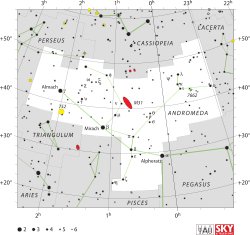Delta Andromedae

| |
| Observation data Epoch J2000.0 Equinox J2000.0 (ICRS) | |
|---|---|
| Constellation | Andromeda |
| Right ascension | 00h 39m 19.67518s[1] |
| Declination | +30° 51′ 39.6783″[1] |
| Apparent magnitude (V) | 3.28[2] |
| Characteristics | |
| Spectral type | K3 III[3] |
| U−B color index | +1.48[2] |
| B−V color index | +1.28[2] |
| R−I color index | +0.66[4] |
| Astrometry | |
| Radial velocity (Rv) | −7.3 ± 0.9[5] km/s |
| Proper motion (μ) | RA: +114.45[1] mas/yr Dec.: −84.02[1] mas/yr |
| Parallax (π) | 30.91 ± 0.15[1] mas |
| Distance | 105.5 ± 0.5 ly (32.4 ± 0.2 pc) |
| Orbit[6] | |
| Period (P) | 15,000 d |
| Eccentricity (e) | 0.34 ± 0.14 |
| Periastron epoch (T) | 2415568 JD |
| Argument of periastron (ω) (primary) | 356.1 ± 5.2° |
| Semi-amplitude (K1) (primary) | 4.0 ± 2.7 km/s |
| Details | |
| δ And A | |
| Mass | ~1.3[7] M☉ |
| Radius | 13.6 ± 0.3[8] R☉ |
| Luminosity | 68 ± 4[8] L☉ |
| Surface gravity (log g) | 2.0 ± 0.3[3] cgs |
| Temperature | 4,315[9] K |
| Metallicity [Fe/H] | 0.04[9] dex |
| Rotational velocity (v sin i) | 6.5[9] km/s |
| Age | 3.2[10] Gyr |
| Other designations | |
| Database references | |
| SIMBAD | data |
Delta Andromedae (δ And, δ Andromedae) is a multiple star system in the northern constellation of Andromeda. Based upon parallax measurements, is located at a distance of approximately 105.5 light-years (32.3 parsecs) from the Earth. Apart from its Bayer designation, it was also given the title Delta by Elijah H. Burritt in his star atlas.[12]
In Chinese, 奎宿 (Kuí Sù), meaning Legs (asterism), refers to an asterism consisting of δ Andromedae, η Andromedae, 65 Piscium, ζ Andromedae, ι Piscium, ε Andromedae, π Andromedae, ν Andromedae, μ Andromedae, β Andromedae, σ Piscium, τ Piscium, 91 Piscium, υ Piscium, φ Piscium, χ Piscium and ψ¹ Piscium. Consequently, δ Andromedae itself is known as 奎宿五 (Kuí Su wǔ, English: the Fifth Star of Legs.)[13]
This is a long-period spectroscopic binary with an orbital period of approximately 15,000 days (41 years) and an overall apparent visual magnitude of approximately 3.28. The primary of the spectroscopic binary has a stellar classification of K3 III, indicating that it is a giant star.[5][6] It most likely evolved from a F-type main sequence star after consuming the hydrogen at its core.[10] The secondary is believed to be relatively faint, as it has not been observed interferometrically. The star has two optical companions, the closest of which may be an orbiting red dwarf of class M3 with a separation of at least 900 astronomical units.[14]
An excess of infrared emission from δ Andromedae suggested that it may be surrounded by a shell of dust.[3] In 2003 it was determined that this is more likely a circumstellar debris disk.[10]
References
- 1 2 3 4 5 van Leeuwen, F. (November 2007), "Validation of the new Hipparcos reduction", Astronomy and Astrophysics, 474 (2): 653–664, arXiv:0708.1752
 , Bibcode:2007A&A...474..653V, doi:10.1051/0004-6361:20078357
, Bibcode:2007A&A...474..653V, doi:10.1051/0004-6361:20078357 - 1 2 3 Johnson, H. L.; et al. (1966). "UBVRIJKL photometry of the bright stars". Communications of the Lunar and Planetary Laboratory. 4 (99). Bibcode:1966CoLPL...4...99J.
- 1 2 3 Judge, P. G.; Jordan, C.; Rowan-Robinson, M. (January 1, 1987), "Delta Andromedae (K3 III) - an IRAS source with an unusual ultraviolet spectrum", Monthly Notices of the Royal Astronomical Society, 224: 93–106, Bibcode:1987MNRAS.224...93J, doi:10.1093/mnras/224.1.93.
- ↑ Hoffleit, D.; Warren, Jr., W. H., "HR 165, database entry", The Bright Star Catalogue (5th (Preliminary Version) ed.), CDS ID V/50. Accessed on line August 28, 2008.
- 1 2 3 NSV 15142 -- Spectroscopic binary, database entry, SIMBAD. Accessed on line August 28, 2008.
- 1 2 Bakos, Gustav A. (February 1976), "The spectroscopic orbit of δ Andromedae", Journal of the Royal Astronomical Society of Canada, 70: 23–26, Bibcode:1976JRASC..70...23B.
- ↑ Gontcharov, G.A.; Kiyaeva, O. V. (2002), "Photocentric orbits from a direct combination of ground-based astrometry with Hipparcos I. Comparison with known orbits", Astronomy and Astrophysics, 391, 647-657, Bibcode:2002A&A...391..647G, doi:10.1051/0004-6361:20020896.
- 1 2 Piau, L.; et al. (February 2011), "Surface convection and red-giant radius measurements", Astronomy and Astrophysics, 526: A100, arXiv:1010.3649
 , Bibcode:2011A&A...526A.100P, doi:10.1051/0004-6361/201014442
, Bibcode:2011A&A...526A.100P, doi:10.1051/0004-6361/201014442 - 1 2 3 Massarotti, Alessandro; et al. (January 2008), "Rotational and Radial Velocities for a Sample of 761 HIPPARCOS Giants and the Role of Binarity", The Astronomical Journal, 135 (1): 209–231, Bibcode:2008AJ....135..209M, doi:10.1088/0004-6256/135/1/209
- 1 2 3 Decin, G.; et al. (November 2003), "Age Dependence of the Vega Phenomenon: Observations", The Astrophysical Journal, 598 (1): 636–644, arXiv:astro-ph/0308294
 , Bibcode:2003ApJ...598..636D, doi:10.1086/378800
, Bibcode:2003ApJ...598..636D, doi:10.1086/378800 - ↑ "Entry 00393+3052", The Washington Double Star Catalog, United States Naval Observatory, retrieved 2008-08-28
- ↑ Richard Hinckley Allen (1899) Star-names and Their Meanings, p. 38.
- ↑ (Chinese) AEEA (Activities of Exhibition and Education in Astronomy) 天文教育資訊網 2006 年 5 月 19 日
- ↑ Kaler, James B., "DELTA AND (Delta Andromedae)", Stars, University of Illinois, retrieved 2012-01-23
External links
- The Constellation Andromeda: The Chained Maiden, web page, European Southern Observatory outreach.
- Entry at heavens-above.com.
- Image Delta Andromedae